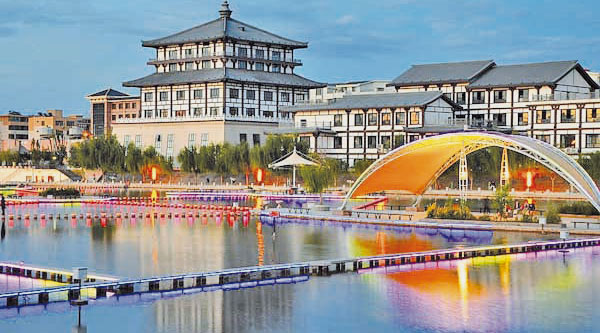

The historic Chinese city of Dunhuang has been a major attraction for tourists from across the world who are keen in archeology and exploration of caves. With the recent Media Cooperation Forum on Belt and Road held at this city in China’s northwestern Gansu province that saw editors-in-chief and other media men flying in from different countries, this city of caves is expected to attract more international tourists from all over the globe.
Dunhuang, a city situated on the edge of the Gobi Desert was once a frontier garrison on the Silk Road and today, it’s known for the Mogao Caves, a complex of 492 caverns adorned with Buddhist statuary and frescoes. These caves, carved into the cliffs above the Dachuan River, were historically created between the 4th and the 14th centuries, according to the Chinese Tourism Authority.
These caves, also known as the Dunhuang Caves, also include other Buddhist cave sites in and around the Dunhuang area. They include the Western Thousand Buddha Caves, Five Temple Caves, Yulin Caves, and Eastern Thousand Buddha Caves which boasts of some of the finest examples of Buddhist art spanning a period of 1,000 years.
“The city of Dunhuang is situated in an oasis containing Crescent Lake and Mingsha Shan meaning “Singing-Sand Mountain” and is named after the sound of the wind whipping off the dunes, the singing sand phenomenon”, a newsletter from the Authority said, adding, “Dunhuang commands a strategic position at the crossroads of the ancient Southern Silk Route and the main road leading from India via Lhasa to Mongolia and Southern Siberia. It also is a strategic point controlling the entrance to the narrow Hexi Corridor, which led straight to the heart of the north Chinese plains and the ancient capitals of Chang’an, which is today known as Xi’an, and Luoyang.”
According to statistics released by China’s Authority, this city which was a vital stop on the ancient Silk Road currently have a population of 187,578. It is also known as Shazhou and in Uyghur, it is referred to as Dukhan.
According to researchers, there is evidence of human habitation in this area as early as 2,000 BC and its name was also mentioned in relation to the homeland of the ‘Yuezhi’ in the Records of the Grand Historian. Well-known archaeologist Lin Meicun has also suggested that Dunhuan may be a Chinese name for the Tukhara, a people widely believed to be a Central Asian offshoot of the ‘Yuezhi’.
“The Great Wall was extended to Dunhuang, and a line of fortified beacon towers stretched westwards into the desert. By the second century AD Dunhuang had a population of more than 76,000 and was a key supply base for caravans that passed through the city: those set out for the arduous trek across the desert loaded up with water and food supplies, and others arriving from the west gratefully looked upon the mirage-like sight of Dunhuang’s walls, which signified safety and comfort”, Tourism Authority statement said.
Media Cooperation Forum on Belt and Road 2017 hosted by largest Chinese daily, ‘People’s Daily’ witnessed over 460 media practitioners from more than 126 countries took part in the one-day event, including more than 160 Chinese journalists and 303 media executives from 156 countries.
The third international media forum since 2014 hosted by the ‘People’s Daily’ within Belt and Road economic initiative, the Media Cooperation Forum on Belt and Road also launched two major projects such as ‘Belt and Road Media Cooperation Centre’ and ‘Cross-border Joint Reporting Project’ composing of journalists from across the globe.
The media men from all media outlets, Newspaper, Radio, and television, as well as social media, discussed global communication, the role of government and enterprises, healthcare, digital economy, tourism and cultural ties are on the agenda.
Kabeer yousuf
Oman Observer is now on the WhatsApp channel. Click here



